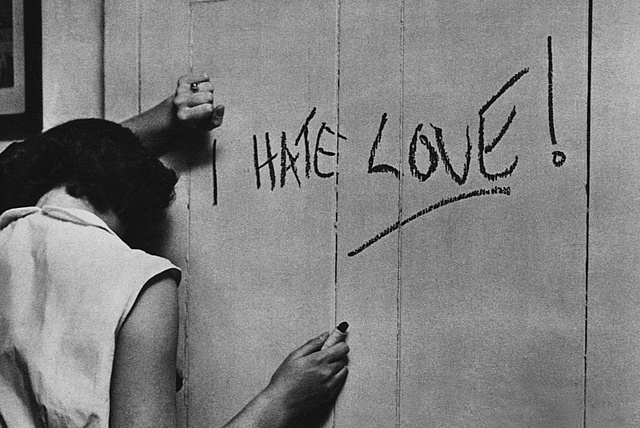STANLEY KUBRICK - Istituto Veneto di Scienze 6.11.2010

STANLEY KUBRICK - Istituto Veneto di Scienze 6.11.2010
"I have always thought that a credible ambiguity, truly realistic, was the best form of expression".
Love of the paradoxical, of the oxymoron, of the ambiguous, is a key to the work of one of the twentieth century's greatest filmmakers: Stanley Kubrick.While his films are known and appreciated by millions, few were aware until now that Kubrick was also a great photographer, in the years just after World War II. From 1945 to 1950 he worked, in fact, for the magazine Look, a popular weekly published in New York that aimed to document social life in post-war America. Rainer Crone, curator of this exhibition and expert in contemporary art, has discovered and studied over 12,000 photographs from this magazine, which had never before been critically or historically analyzed.
The exhibition at Venetian Institute in Venice is not a simple collection of photographs by an artist, no matter how important, but a series of 'stories' told in images, forming a historically unique corpus through which we can read, in clearly identifiable form, the great film director's style and unique flair for 'story-telling'.
Specifically, this collection allows us to convincingly decipher some of the cultural references that were to become characteristic of Kubrick the film director as well; first among them, the theme of the artist's 'estrangement' from his own work of art.
Kubrick lived in New York at the time when Brecht was encountering smashing success with his Three Penny Opera. And the future film director, of Jewish origin, surely recognized himself in the German cultural trend starting with Expressionism, and in the belief that a 'stylized' portrayal of reality could be much more striking that a 'natural' documentation. Already Proust had pointed out the particular nature of a photographic approach to reality, which becomes a sort of 'alienation' from it. In the light of Brecht's later work, this 'alienation' is then transformed, in Kubrick, into experimentation with his own emotions and experience before the fragment of reality framed by his camera. And lastly, we find the young Kubrick's burning interest in representing all that is blurred and uncertain, his fascination with what no longer exists, or has not yet come into existence. This was, moreover, a specific characteristic of the American culture that was then forcefully emerging in its originality and its attempt to break away from its European roots.
he exhibition has been produced in collaboration with the Museum of the City of New York and the Library of Congress in Washington, which possess a still unknown treasure of over 20,000 negatives by the young Stanley Kubrick, already a great photographer at the age of only 17. These photos document the daily life of America in the early post-war period with such celebrities as Rocky Graziano and Montgomery Clift, and depict the daily life of Dixieland jazz musicians in striking, ironic shots taken in a New York about to become the new world capital.
This initiative will reveal Stanley Kubrick's manner of photographing, one of the ardent interests he inherited as a boy from his father (the other being the game of chess). His first photograph, published on June 26, 1945, shows a newspaper seller overcome with grief at the death of Roosevelt, an image that fascinated the editors of Look to the point of offering the young Kubrick a job with the magazine as photo-reporter.
The Look method, that of using photographs to tell a story a story in episodes, was frowned upon by the leading photojournalists of the time. The editors of the magazine wanted the photographer to follow a subject constantly, shooting pictures of everything he did. This invasive style was highly congenial to Kubrick, who liked to create stories starting just from such photos. Much of the aesthetic sense we find later in his films was already being expressed in his work from these years. To capture his subjects in the most natural poses, Kubrick employed various stratagems to pass unobserved, such as hiding the camera under the sleeve of his jacket and shooting the picture with a switch concealed in his hand. Recurring to special angles of observation and always retaining a certain detachment, he also managed to reveal the psychological aspects of his subjects, allowing the viewer of the picture to form a personal interpretation of the character of each person portrayed.
"These were the origins of Stanley Kubrickís first photographs, shot in early post-war America, surprising insofar as they are not limited to representing an epoch, as might be expected of a photo reporter. His shots, in factí, notes the curator, ëwhich astonish us for their unexpected maturity, cannot be considered visual archives of the joy of living, captured by the attentive, humorous spirit of a young man, but are instead a knowledgeable invitation to analyze the resources of the photographic means, its possibilities of representation and its own perception of reality: a constant factor in Kubrickís artistic work, beginning with his photographs and continuing in his films."
A fundamental passage, then, when we consider that the ambiguity of the image and of the cinema itself are central to the spirit animating the cinematic auteurs of the post-war period, who are for this reason termed modern, and of whom Kubrick was one of the unquestioned masters.
STANLEY KUBRICK. Photographer
Venice, Istituto Veneto di Scienze Lettere ed Arti, Palazzo Cavalli Franchetti (Campo Santo Stefano)
until 14 November 2010
Opening hours: every day from 10 a.m. to 7.00 p.m. The ticket office closes at 6.30 p.m.
Diesen Artikel verlinken: http://acommunity.at/A/kjta - Artikel empfehlen: Tweet

























































